Time Series Forecasting Case Study on Risk-Based Asset Integrity Management for Low-Voltage Failures of Power Distribution Systems †
Abstract
1. Introduction
2. Research Background
2.1. Assets, Risk, Maintenance Management, AIM, and RBAIM
2.2. Time Series Analysis and Forecasting
3. Case Study Methodology and Development
3.1. Use of Case Study Methodology
3.2. The Case Study Background
3.2.1. LV Fuses
3.2.2. Probability of LV Failure
3.2.3. SAIDI and Consequence of Failure (CoF)
3.2.4. Risk Index Determination
3.3. Development of Time Series Analysis Forecasting Based on RBAIM Methodology
Detailed Mathematic Modeling
4. Data Collection and Analysis
5. Results and Discussion
6. Conclusions and Recommendations
Author Contributions
Funding
Institutional Review Board Statement
Informed Consent Statement
Data Availability Statement
Conflicts of Interest
References
- Nordgard, D.E.; Gjerde, K.S.O.; Catrinu, M.D.; Lassila, J.; Jartanen, J.; Bonnoit, S.; Aupied, J. A Risk based Approach to Distribution System Asset Management and A Survey of Perceived Risk Exposure Among Distribution Companies. In Proceedings of the 19th International Conference on Electricity Distribution, Vienna, Austria, 21–24 May 2007. [Google Scholar]
- Aliyari, M.; Ayele, Y.Z. Risk analysis in low-voltage distribution systems. Proc. Inst. Mech. Eng. Part O J. Risk Reliab. 2018, 233, 118–138. [Google Scholar] [CrossRef]
- Ratnayake, R.M.C.; Markeset, T. Asset integrity management for sustainable industrial operations: Measuring the performance. Int. J. Sustain. Eng. 2012, 5, 145–158. [Google Scholar] [CrossRef]
- Ratnayake, R.M.C. Sustainable performance of industrial assets: The role of PAS 55-1&2 and human factors. Int. J. Sustain. Eng. 2013, 6, 198–211. [Google Scholar] [CrossRef]
- Mirhosseini, M.; Keynia, F. Asset management and maintenance programming for power distribution systems: A review. IET Gener. Transm. Distrib. 2021, 15, 2287–2297. [Google Scholar] [CrossRef]
- Wallnerstrom, C.J.; Bertling, L. Risk Management applied to Electrical Distribution Systems. In Proceedings of the 20th International Conference on Electricity Distribution, Prague, Czech Republic, 8–11 June 2009. [Google Scholar] [CrossRef]
- Nordgård, D.E.; Samdal, K. Establishing risk-based maintenance strategies for electricity distribution companies. In Reliability, Risk and Safety Three Volume Set; CRC Press: Boca Raton, FL, USA, 2009. [Google Scholar]
- Zhao, M.-X.; Su, J.; Liu, S.-G. Risk assessment based maintenance management for distribution network. J. Int. Counc. Electr. Eng. 2014, 2, 84–89. [Google Scholar] [CrossRef]
- Attanayake, A.M.S.R.H.; Ratnayake, R.M.C. On the Necessity of Using Supervised Machine Learning for Risk-Based Screening of Distribution Transformers: An Industrial Case Study. In Proceedings of the IEEE International Conference on Industrial Engineering and Engineering Management (IEEM), Kuala Lumpur, Malaysia, 7–10 December 2022; pp. 0468–0473. [Google Scholar] [CrossRef]
- Attanayake, A.M.S.R.H.; Ratnayake, R.M.C. Risk-Based Inspection and Maintenance Analysis of Distribution Transformers: Development of a Risk Matrix and Fuzzy Logic Based Analysis Approach. In Proceedings of the IEEE International Conference on Industrial Engineering and Engineering Management (IEEM), Kuala Lumpur, Malaysia, 7–10 December 2022; pp. 0457–0462. [Google Scholar] [CrossRef]
- Gitelman, L.D.; Kozhevnikov, M.V.; Chebotareva, G.S.; Kaimanova, O.A. Asset Management of Energy Company Based on Risk-Oriented Strategy. In Energy Production and Management in the 21st Century IV: The Quest for Sustainable Energy; WIT Press: Southampton, UK, 2020; pp. 125–135. [Google Scholar]
- Saha, E.; Saha, R.; Mridha, K. Short-Term Electricity Consumption Forecasting: Time-Series Approaches. In Proceedings of the 2022 10th International Conference on Reliability, Infocom Technologies and Optimization (Trends and Future Directions) (ICRITO), Noida, India, 13–14 October 2022; pp. 1–5. [Google Scholar] [CrossRef]
- Bitos, M.; Mills, D.; Ashton, S.R. Utilising Forecasting Time Series Data and Flexibility Services to manage Distribution Networks. In Proceedings of the CIRED 2021—The 26th International Conference and Exhibition on Electricity Distribution, Online Conference, online, 20–23 September 2021; pp. 2760–2763. [Google Scholar] [CrossRef]
- Çetinkaya, Ü.; Avcı, E.; Bayindir, R. Time Series Clustering Analysis of Energy Consumption Data. In Proceedings of the 2020 9th International Conference on Renewable Energy Research and Application (ICRERA), Glasgow, UK, 27–30 September 2020; pp. 409–413. [Google Scholar] [CrossRef]
- Kindalkar, S.S.; Itagi, A.R.; Kappali, M.; Karajgi, S. Time Series Based Short Term Load Forecasting using Prophet for Distribution System. In Proceedings of the 2022 International Conference on Smart Generation Computing, Communication and Networking (SMART GENCON), Bangalore, India, 23–25 December 2022; pp. 1–6. [Google Scholar] [CrossRef]
- Attanayake, A.M.S.R.H.; Ratnayake, R.M.C. Digitalization of Distribution Transformer Failure Probability Using Weibull Approach towards Digital Transformation of Power Distribution Systems. Future Internet 2023, 15, 45. [Google Scholar] [CrossRef]
- Goswami, K.; Kandali, A.B. Electricity Demand Prediction using Data Driven Forecasting Scheme: ARIMA and SARIMA for Real-Time Load Data of Assam. In Proceedings of the 2020 International Conference on Computational Performance Evaluation (ComPE), Shillong, India, 2–4 July 2020; pp. 570–574. [Google Scholar] [CrossRef]
- Shumway, R.H.; Stoffer, D.S. Time Series Analysis and Its Applications with R Examples, 3rd ed.; Springer: Berlin/Heidelberg, Germany, 2016; p. 568. [Google Scholar] [CrossRef]
- Mehairjan, R.P.Y. Risk-Based Maintenance for Electricity Network Organizations; Springer International Publishing: Cham, Switzerland, 2016. [Google Scholar]
- Gomez, J.F.; Galan, P.M.; Guillen, A.J.; Crespo, A. Risk-based criticality for network utilities asset management. IEEE Trans. Netw. Serv. Manag. 2019, 16, 755–768. [Google Scholar] [CrossRef]
- Reyes-Picknell, J. An Introduction to PAS 55—Optimal Management of Physical Assets. Available online: https://reliabilityweb.com/articles/entry/an_introduction_to_pas_55_optimal_management_of_physical_assets (accessed on 12 February 2023).
- ISO55001 Asset Management Systems. Available online: https://saiassurance.com.au/iso-55001/#:~:text=ISO%2055001%20Asset%20Management%20Systems%20helps%20organisations%20manage%20assets%20more,the%20value%20of%20their%20assets (accessed on 12 February 2023).
- ISO 31000 Risk Management. Available online: https://www.iso.org/iso-31000-risk-management.html (accessed on 12 February 2023).
- ISO 9001 and Related Standards in Quality Management. Available online: https://www.iso.org/iso-9001-quality-management.html (accessed on 12 February 2023).
- Li, Y.; Yeddanapudi, S.; McCalley, J.; Chowdhury, A.; Jewell, W. Resource Management for Distribution System Maintenance Using Optimized Risk Reduction. In Proceedings of the 2006 International Conference on Probabilistic Methods Applied to Power Systems, Stockholm, Sweden, 11–15 June 2006. [Google Scholar] [CrossRef]
- Khan, F.I.; Haddara, M.M. Risk-based maintenance (RBM): A quantitative approach for maintenance/inspection scheduling and planning. J. Loss Prev. Process Ind. 2003, 16, 561–573. [Google Scholar] [CrossRef]
- Georgiou, A.D. An Introduction to Time Series Forecasting. 2021. Available online: https://www.infoworld.com/article/3622246/an-introduction-to-time-series-forecasting.html (accessed on 12 February 2023).
- Jain, A.; Gadia, H.; Sukhdeve, T.; Sahu, S.P.; Verma, S. COVID19 Prediction using Time Series Analysis. In Proceedings of the 2021 International Conference on Artificial Intelligence and Smart Systems (ICAIS), Pichanur, India, 25–27 March 2021; pp. 1599–1606. [Google Scholar] [CrossRef]
- Introduction to Time Series Analysis. Available online: https://www.itl.nist.gov/div898/handbook/pmc/section4/pmc4.html (accessed on 12 February 2023).
- Yin, R.K. Case Study Research and Applications Design and Methods; Sage Publications, Inc.: Thousand Oaks, CA, USA, 2018. [Google Scholar]
- Lucas, J.R.; Udayakanthi, M.V.P.G. Identification of Causes of Distribution Transformer Failures and Introduction of Measures to Minimize Failures; Department of Electrical Engineering, University of Moratuwa: Moratuwa, Sri Lanka, 2015. [Google Scholar]
- Operating Manual Area Electrical Engineer; Ceylon Electricity Board: Colombo, Sri Lanka, 2016.
- Jacob, S. Time Series Forecast: A Basic Introduction Using Python. 2017. Available online: https://medium.com/@stallonejacob/time-series-forecast-a-basic-introduction-using-python-414fcb963000#:~:text=Time%20series%20forecasting%20is%20basically,Handling%20Ti.me%20Series%20in%20Pandas (accessed on 2 January 2023).
- Peixeiro, M. The Complete Guide to Time Series Analysis and Forecasting. 2019. Available online: https://towardsdatascience.com/the-complete-guide-to-time-series-analysis-and-forecasting-70d476bfe775 (accessed on 2 January 2023).
- Li, S. An End-to-End Project on Time Series Analysis and Forecasting with Python. 2018. Available online: https://towardsdatascience.com/an-end-to-end-project-on-time-series-analysis-and-forecasting-with-python-4835e6bf050b (accessed on 2 January 2023).
- Box, G.E.P.; Jenkins, G.M.; Reinsel, G.C.; Ljung, G.M. Time Series Analysis: Forecasting and Control, 5th ed.; John Wiley & Sons Incorporated: New York, NY, USA, 2015. [Google Scholar]

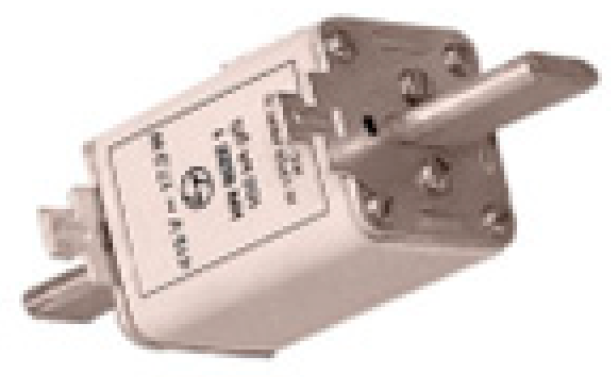
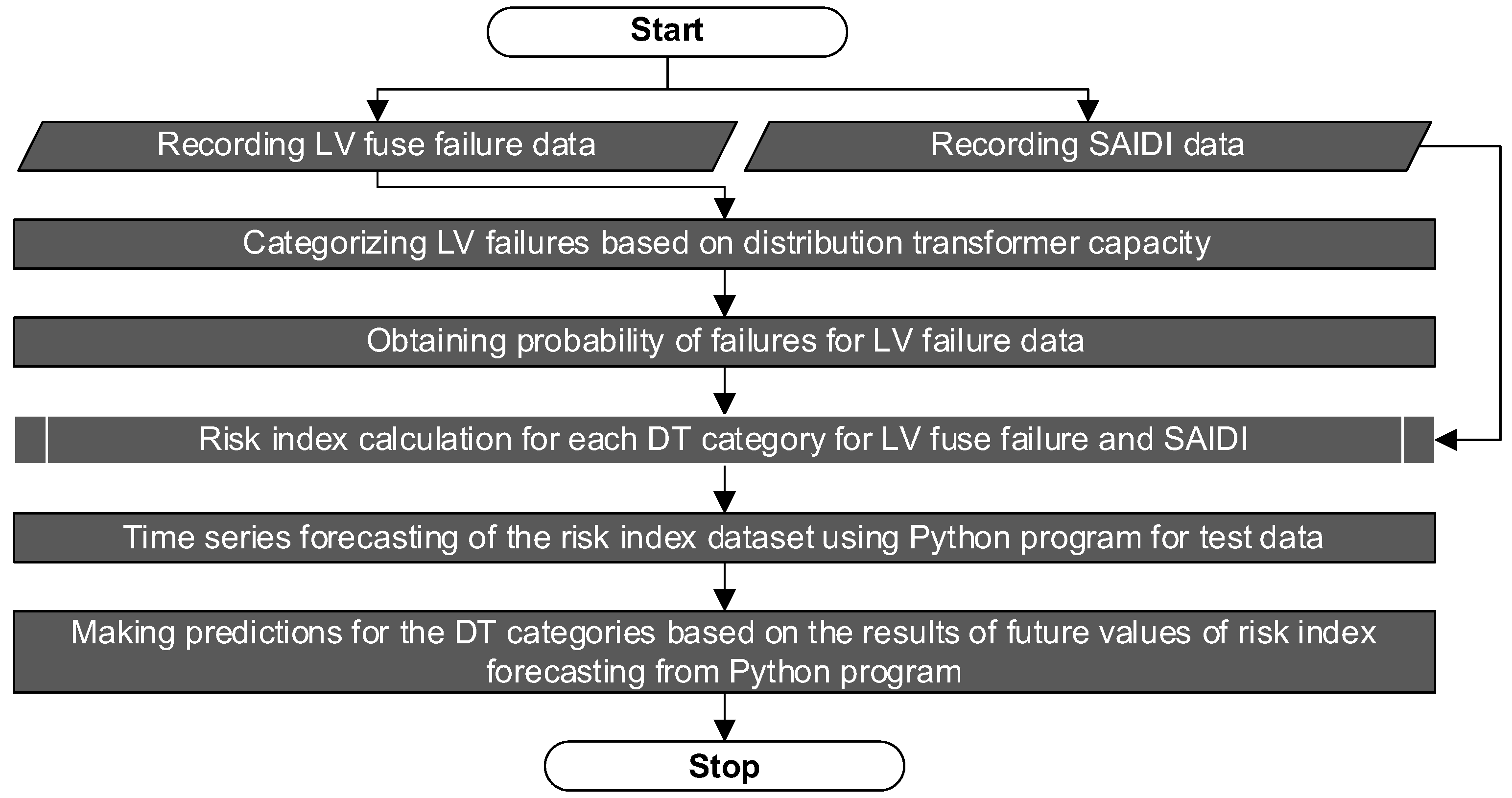

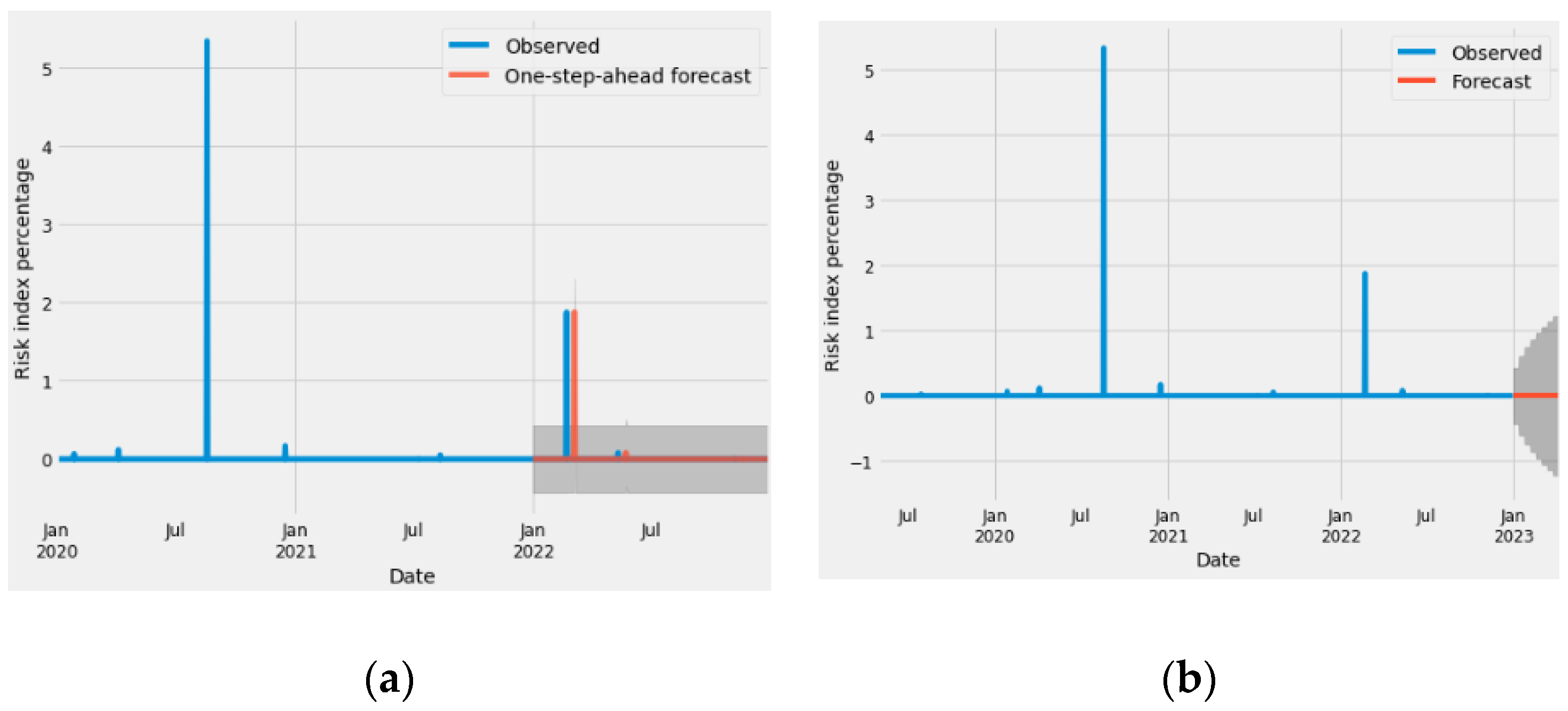
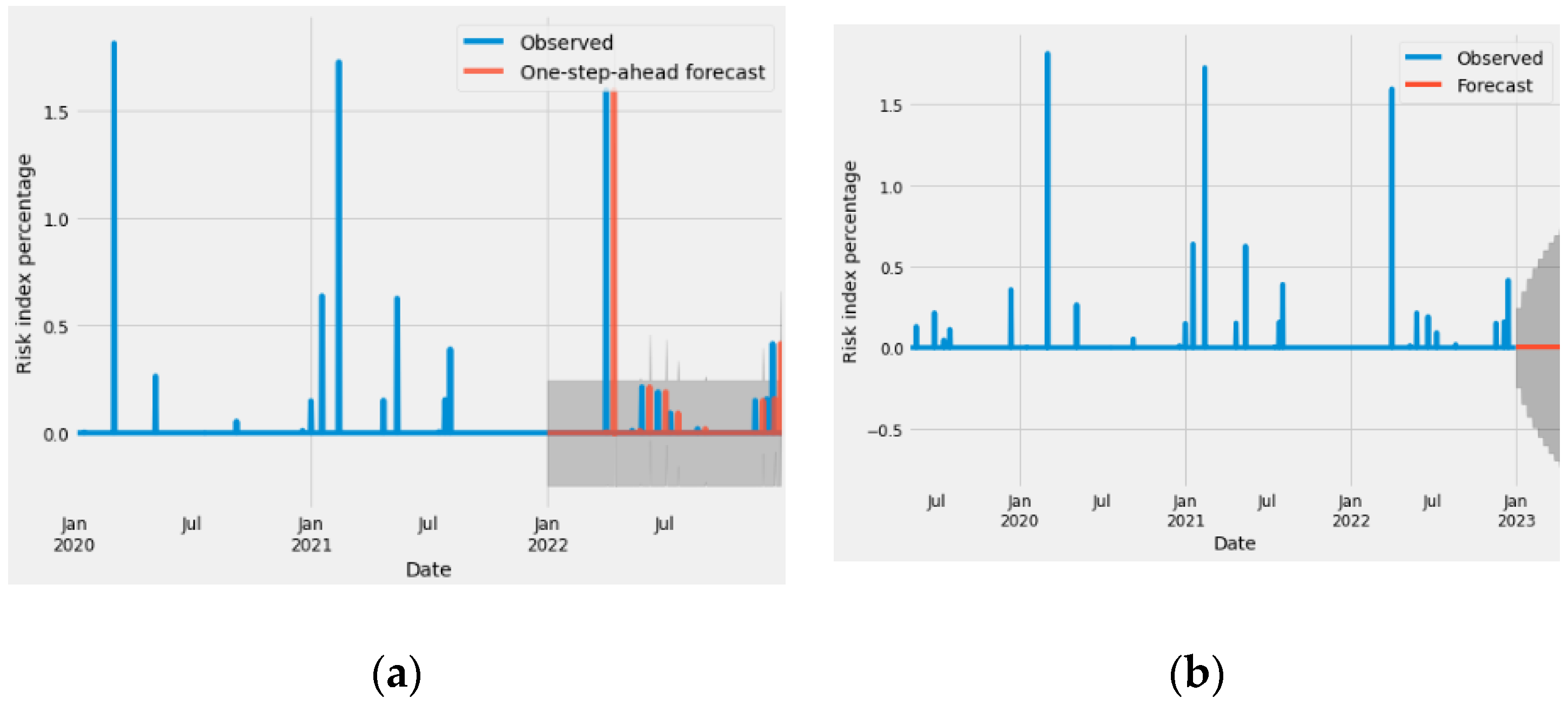


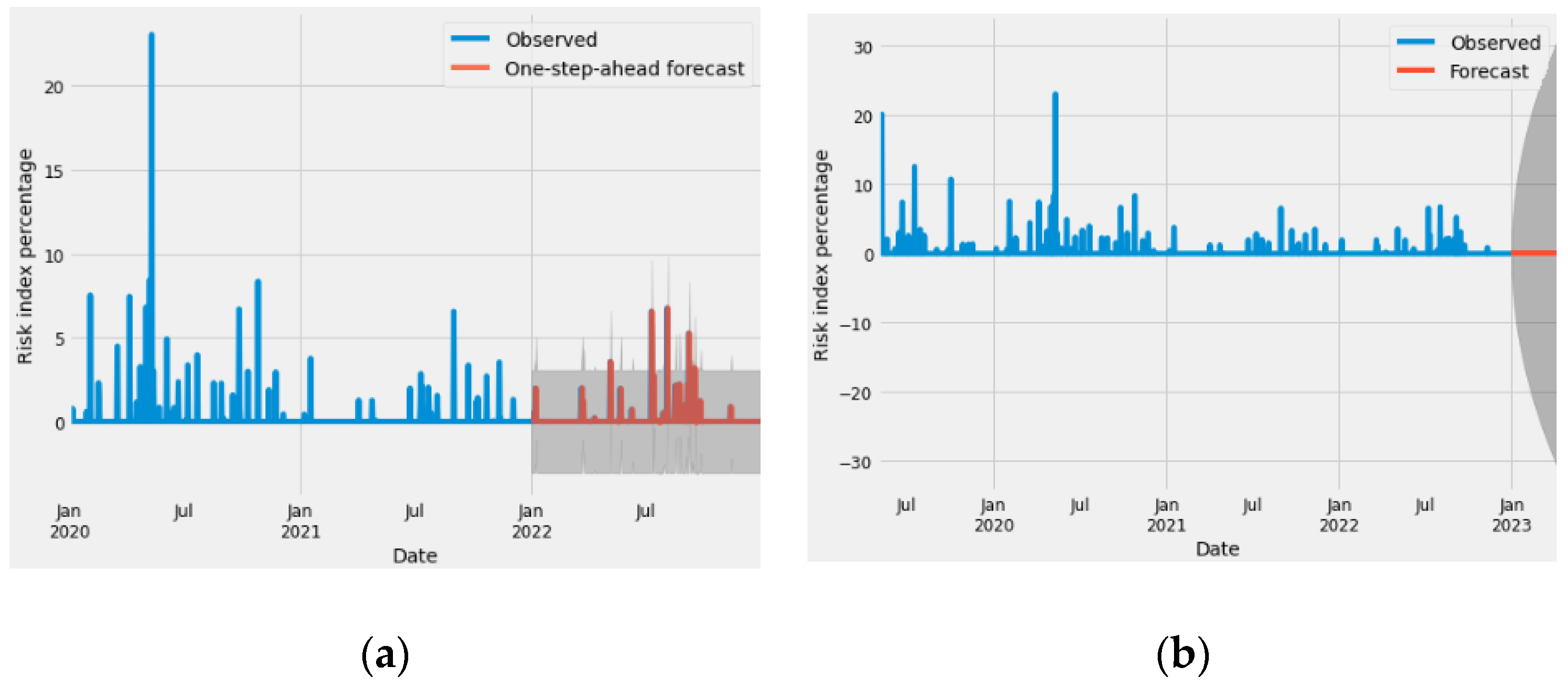
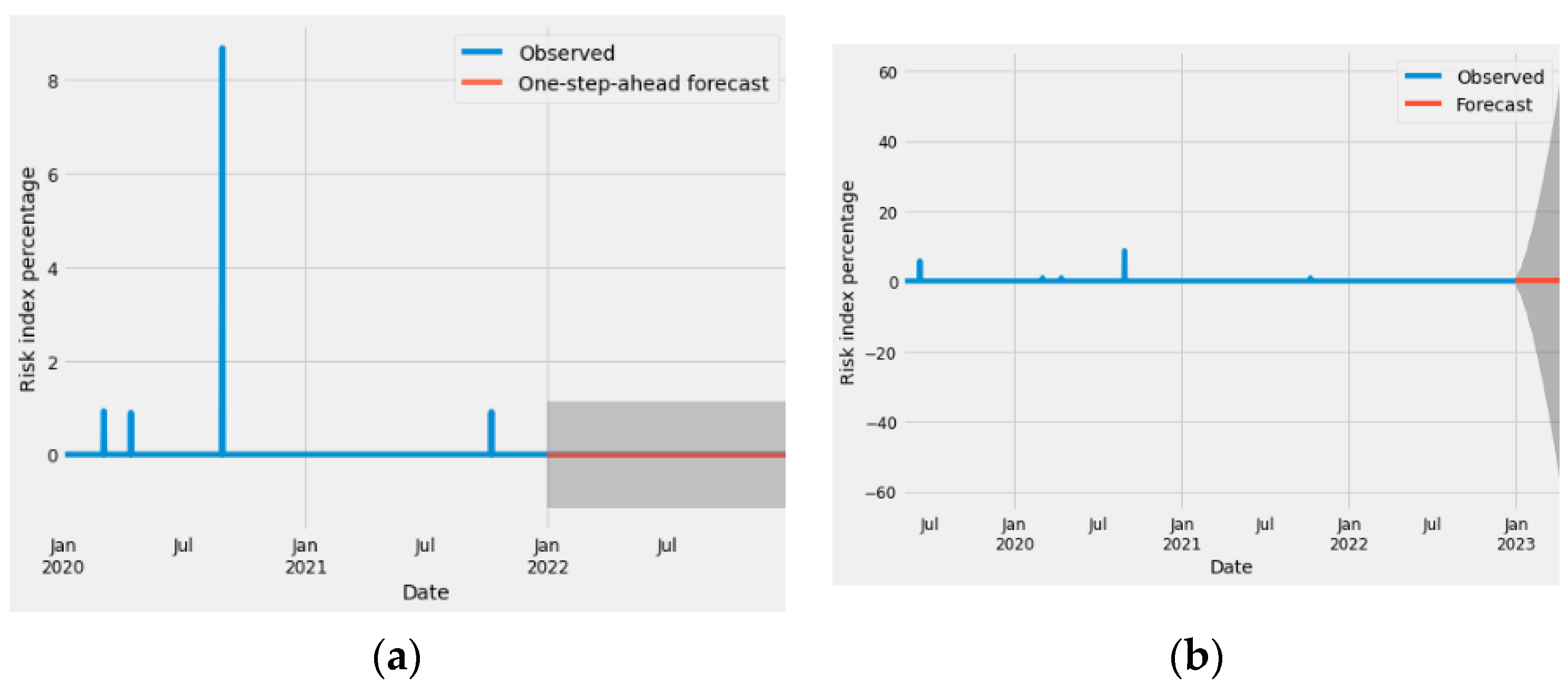
| 11 kV/0.4 kV DT Category of LV Fuses | The Average Risk Index Prediction Values | Risk Rank |
|---|---|---|
| 100 kVA | 0.8968 | 3 (moderate) |
| 160 kVA | 0.5102 | 2 (low) |
| 250 kVA | 5.0452 | 4 (high) |
| 400 kVA | 5.2839 | 4 (high) |
| 630 kVA | 20.8804 | 5 (very high) |
| 800 kVA | 0.0011 | 1 (very low) |
| Transformer Category of LV Fuses | Mean Squared Error (MSE) of the Forecast | Root Mean Squared Error (RMSE) of the Forecast |
|---|---|---|
| 100 kVA | 0.02 | 0.14 |
| 160 kVA | 0.02 | 0.13 |
| 250 kVA | 1.85 | 1.36 |
| 400 kVA | 1.06 | 1.03 |
| 630 kVA | 0.97 | 0.98 |
| 800 kVA | 0.0 | 0.0 |
Disclaimer/Publisher’s Note: The statements, opinions and data contained in all publications are solely those of the individual author(s) and contributor(s) and not of MDPI and/or the editor(s). MDPI and/or the editor(s) disclaim responsibility for any injury to people or property resulting from any ideas, methods, instructions or products referred to in the content. |
© 2023 by the authors. Licensee MDPI, Basel, Switzerland. This article is an open access article distributed under the terms and conditions of the Creative Commons Attribution (CC BY) license (https://creativecommons.org/licenses/by/4.0/).
Share and Cite
Attanayake, A.M.S.R.H.; Ratnayake, R.M.C. Time Series Forecasting Case Study on Risk-Based Asset Integrity Management for Low-Voltage Failures of Power Distribution Systems. Eng. Proc. 2023, 39, 17. https://doi.org/10.3390/engproc2023039017
Attanayake AMSRH, Ratnayake RMC. Time Series Forecasting Case Study on Risk-Based Asset Integrity Management for Low-Voltage Failures of Power Distribution Systems. Engineering Proceedings. 2023; 39(1):17. https://doi.org/10.3390/engproc2023039017
Chicago/Turabian StyleAttanayake, A. M. Sakura R. H., and R. M. Chandima Ratnayake. 2023. "Time Series Forecasting Case Study on Risk-Based Asset Integrity Management for Low-Voltage Failures of Power Distribution Systems" Engineering Proceedings 39, no. 1: 17. https://doi.org/10.3390/engproc2023039017
APA StyleAttanayake, A. M. S. R. H., & Ratnayake, R. M. C. (2023). Time Series Forecasting Case Study on Risk-Based Asset Integrity Management for Low-Voltage Failures of Power Distribution Systems. Engineering Proceedings, 39(1), 17. https://doi.org/10.3390/engproc2023039017







